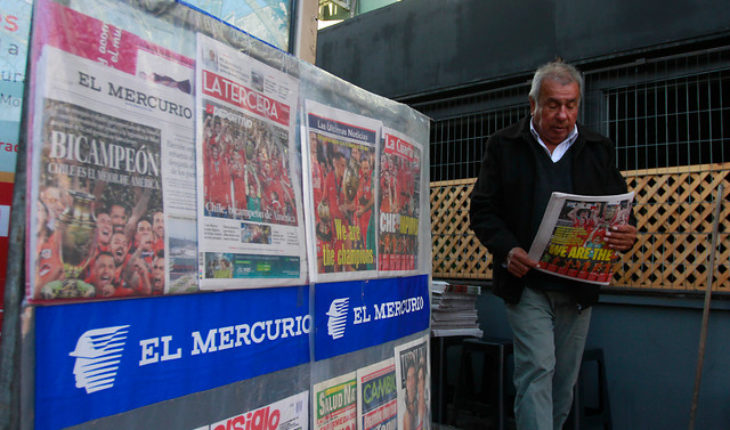The issue of media concentration in Chile and the crisis of local industry, in tune with the rest of the world, have already become indisputable realities. The State’s preference for certain media consortia to promote their public policy campaigns is also not a new issue. But what does seem like a novelty is the lack of transparency in the state’s spending on media and advertising. According to the report released wednesday by El Mostrador, the state spends about US$43 million a year on advertising and only two-thirds of that total, about $27 million can be tracked, as determined by a study by the NGO, Observatory of Tax Expenditure.
The information known did not leave parliamentarians indifferent, as Congress is one of the institutions that, through the Joint Committee on Budget, must monitor the good execution of spending. Deputy Juan Luis Castro (PS) acknowledged that “the amount of more than $15 million that is unknown where they are distributed, which media outlets and state agencies participate, sponsor and spend precisely on advertising in those media. What’s in return for it? What is in a way securing the State from an oligopolistic concentration of advertising media that allow propaganda to be made to the interests of all Chileans?” asked the parliamentarian.
Castro, a member of the House Ethics Committee, emphasized that “this is quite embarrassing because it shows that there are perverse incentives that are behind advertising and that the State of Chile is captured by large consortia that are finally the channels distribution of advertising and all the products that the State wants to install in the public based on the interests of certain groups that are with which they trade in the market, that advertising”.
More public silver in the dark
Evidence that the evidence presented in the study of the Observatory on Fiscal Expenditure reaffirms a moderately well-known diagnosis is the words of MR Tomás Hirsch of the Humanist Party that is part of the Broad Front.
Hirsch acknowledged that the current scenario is a problem that drags on from a return to democracy. “I was not surprised in the least because for a long time we see how the State relies on an enormous amount of resources to the media belonging to the duopoly, El Mercurio and La Tercera. Now, this has been repeated in all governments, not only in the right-wing but also in the governments of the Concertación at the time, and the New Majority, they delivered a very high percentage of resources to those same media,” Hirsch recalled.
However, the MP acknowledged that the scenario is now even more adverse to the independent press. But also, because there is a clear diagnosis, it is the opportunity to put together wills to improve in this area. “This reinforces my need for a project that we have been working on for a long time in the deputation that is a media law. A law that guarantees pluralism and the delivery of resources by the State and governments in a balanced way to all means and that of course does not allow vertical integration and participation in other businesses to those in the media communication,” Hirsch said.
The parliamentarian believes that the “dark silver” spent on the media is a matter of gravity equivalent to other public money scandals involved, such as those that have been known in recent months. “One can perfectly assume that we are facing another scandal, of another diversion of money of enormous sum, as we have been seeing in other institutions. Now, there would be irregularities that need to be investigated with respect to advertising expenditures. The least expected is for the Government to give a reasonable explanation as to where this difference is between 27 and 43 million.” Hirsch said.
For the President of the Council for Transparency, Jorge Jaraquemada part of the solution to clear the opacity around this amount of resources, is to implement a public access platform that contains the surrender of these expenses and can be monitored by the citizens.
“It will always be favorable for a healthy democracy to use the tools of transparency for accountability to the public. In this particular sense we see that in this particular case there is a positive but disjointed intention that must be perfected on a single platform easily accessible to expeditiously charge the scrutiny of public acts of the State in advertising expenses,” he said Jaraquemada.
Vertical integration, myth and comptroller’s
The one who has direct experience in the execution of this budget is the engineer Carlos Correa who worked in the Secretariat of Communications (Secom) in part of the second government of Michelle Bachelet.
Correa emphasizes that the law obliges the government on duty to inform Congress of its spending on advertising, through the Joint Budget Commission. Therefore, he acknowledges that it causes him strangeness that this was not currently being done properly.
“The Government has an obligation to inform Congress, and there is an obligation established in the budget glossary, to invest in regional means that are not chain, that is, it cannot be El Mercurio, 40% of each campaign and that amount you have to report it to the Mi Commission Budget xta,” he explains.
In any case, Correa agrees with the conclusion of the Observatory of Fiscal Expenditure that the State is not a warning of the most important, as to be decisive in the survival of a medium, except regional ones.
“The state is not a great warning. It’s a half-downward warning. Therefore, the State’s resource is allocated in a medium a versus a half B is not enough to save a medium. It is not the oxygen balloon, it is very important for the regional media, so the law establishes 40%. I think it’s appropriate because it strengthens regionalism,” he acknowledges.
Correa agrees with Tomás Hirsch that the vertical integration of advertising agencies is an issue that makes it more complex to achieve a scenario of greater transparency. “There is one problem we couldn’t solve which is vertical integration between advertising agencies and media agencies. On top of that, the media agency market is a little distorted because mediaplanners receive incentives from large media to put advertising on them. There’s a distortion in the agency market. The media agency always puts publicity on the big one. In the previous government we sought to disintegrate it into the framework agreement, but it is not enough because we were not the most important warning in the market,” he explains.
Another difficulty is that the State is conditioned to put warnings in high-circulation mass media to ensure the effectiveness of campaigns and thus act as required by the Comptroller’s Office that oversees the effectiveness of the dissemination of public programs and that it does not it’s “ideological propaganda.”
“The Counterloria reviews media plans so that spending is not an ideological expense and therefore bets on media that are known to the people and high pulls. The accusation of financing the big media is generally unfair. You can’t target non-massive media,” Correa says.
And by the way, he’s trying to bring down what – in his view – is a myth: “State publicity is not what will allow the media to be pluralised. There’s a lot of myth in this. In Chile there is a concentration of media but it is not stowed by state advertising. It has to do with other market conditions. First the TV channels were bought by huge economic groups that have lost silver like crazy and therefore have generated entry barriers for independent channels,” he says.
However, the state says it has options to help maintain an independent media industry, or at least not as concentrated. “There is a billion-peso media fund that is insufficient and one way would be to strengthen it, rather than state advertising that will always be conditioned by the state’s obligation to use mass media for people to learn about public policy” Concludes
translated from Spanish: State warning: MPs demand explanations for $15 million in nebula
June 26, 2019 |





